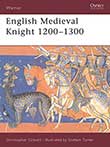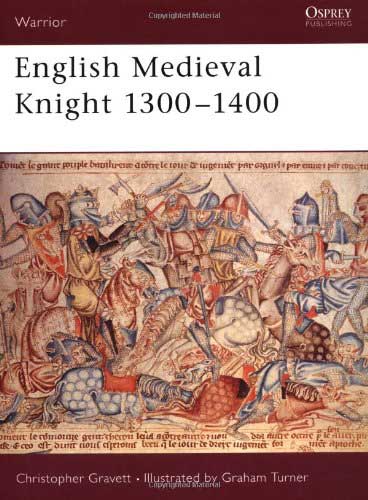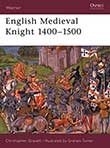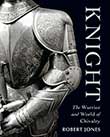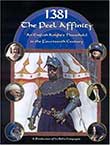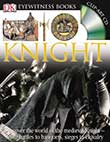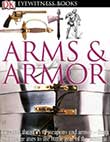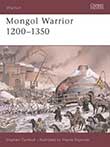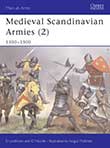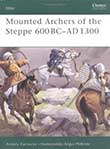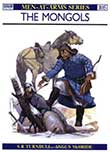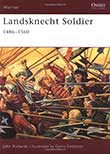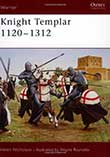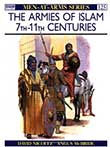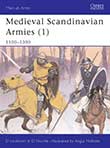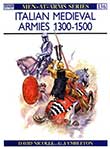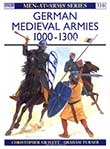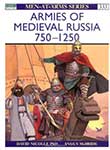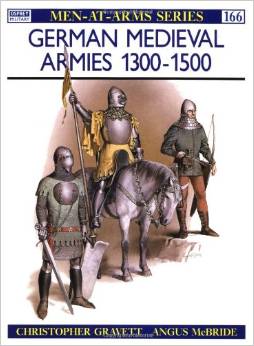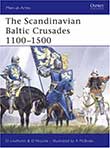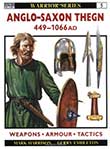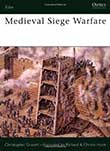

The 13th century was a time of change for knights in England. They were faced with rising costs and increasing demands on their time for local government because of their very status in society, until knighthood itself was sometimes avoided. This period saw as well the development of the tournament from the wild team events of the early years of the century to the single jousts with blunt lance. Campaign life in the 13th century also embraced several theatres of war including the baronial revolt against King John, the Barons' Wars of Simon de Montfort (also known as the Second Barons' War, (1264–1267)), and the Welsh and Scottish wars of Edward I. This title also covers the use and development of arms, armour, costume and other equipment.
The 14th-century knight lived in a century of change, in terms of both recruitment methods and the appearance of fighting men. This book describes all aspects of the knight's life, including his training in the castle yard and the hard knocks of tournaments. The knight's daily routine on campaign is explored along with the role of mercenary knights, the motivation of knights in the field and the influence of chivalry. The book is beautifully illustrated with eight colour plates by Graham Turner covering all aspects of knighthood in this period and also includes photographs of rare surviving contemporary pieces of armour.
The 15th century was a time of change for knighthood. Knights no longer fought for their lords in return for land, since the feudal summons had long before given way to a system of contracts. Moreover, many knights now preferred the role of landowner, man-about-town or parliamentary representative. However, this was also the age of the knight in plate armour, of the battle of Agincourt and the conquests of Henry V, and of the Wars of the Roses, the bloody internecine struggle that tore medieval England apart. In this title Christopher Gravett describes the life of a 15th century knight, his equipment and experiences from his earliest days as a squire through to his experiences on the battlefields of England and France.
From a life-long student of the medieval long sword and medieval history comes a comprehensive overview of the Age of the Knights. Jones shows that behind the popular image of the knight in shining armor lies a world that is both more complex and more fascinating. Were knights glory-seeking, bloodthirsty thugs that lay ravage to the Holy Land or simple Christians serving their king? Jones explores the myths and controversies behind their battle-effectiveness and chivalric code. He also examines knighthood as a "career path" and investigates the role of the knight in law and justice. Lavishly illustrated and drawing on rare first-hand accounts, this book reveals the world of the knight in all its tarnished glory.
1381: The Peel Affinity builds a portrait of a world long lost, using gorgeous photographs filled with carefully researched and reconstructed clothing, tools, armor, furnishings, and other items, all based closely on surviving artefacts, manuscript illustrations, and paintings. The text draws extensive details from historical accounts, records, chronicles, and literature, as well as modern historical and archaeological research. All this potentially dull and dusty detail is brought to vibrant life with a narrative that follows an English knight and family, his servants, officials and tenants, associates and soldiers through a year in their lives. The Peel Affinity represents the culmination of years of work by La Belle Compagnie. Founded in 1992, La Belle is a group of independent scholars and history enthusiasts committed to the presentation of history through the medium of "living history." La Belle Compagnie has worked with schools, civic groups, museums, and other organizations to bring a bit of the past to life and has won numerous awards for its presentations.
Detailed photographs trace the origins, heyday, and eventual decline of knighthood, chivalry, and the feudal system. While studying the Middle Ages, you can’t do that without learning more about knights and their chivalry. So obviously, the Eyewitness series has a book specifically dedicated to knighthood. You will learn everything that you wanted to know about the life as a knight with information about the first knights, the Normans, making a knight, iron everywhere, fashion in steel, the armor, the arms, on horseback, the castle, the castle at war, siege warfare, arming for the fight, the enemy, into battle, the castle at peace, the lord of the manor, the lady of the manor, the ideal of chivalry, the tournament, the joust, foot combat, heraldry, hunting and hawking, faith and pilgrimage, the crusades, Knights of Christ, Knights of the Rising Sun, the professionals, the decline of chivalry and much more.
The book is packed with information that will deepen your knowledge on knights. Throught the pages of this book, you will have plenty of photos and illustrations to help you visualize the life of a knight during the Middle Ages. A timeline as well as a glossary complete the book.
DK eyewitness books are some of the greatest non-fiction books around. The distinctive white background and high-quality photography gives this book an edge over any other nonfiction picture book. And—these pictures are real! They're beautiful museum-quality photos of all things related to knights, accompanied by informative captions and text.
Learn about medieval life, knights, armor, etc. If you know someone (young or old) who is fascinated by medieval times and knights, then you must introduce them to this book!
Now reissued with a CD and wall chart! Eyewitness Arms and Armor is an original and exciting look at the history of weapons and armor through the ages. Stunning real-life photographs reveal the design, construction, and workings of armor, offering a unique "eyewitness" view of how methods of warfare have changed.
In a world where even toy guns are reviled by pacifistic parents there exists the extraordinary Eyewitness Book Arms & Armor. Studying weaponry is an unusual, fascinating angle on human history, as people have always used weapons to hunt, defend themselves, or attack. This intriguing photo essay examines the design, construction, and use of hand weapons and armor--from the Stone Age axe to the revolvers and rifles of the Wild West. In the tradition of the Eyewitness series, Arms & Armor begins with a short introduction to prehistoric weapons, accompanied by a photograph-rich spread with fascinating, history-packed, fun-fact-loaded captions. The Los Angeles Times Book Review says the Eyewitness Books are "like a mini-museum between the covers of a book," and they are right! From crude Paleolithic hand axes, we progress to missile weapons; the first warriors (and the effect of the discovery of copper and bronze on tools and weapons); the weapons of the armies of ancient times; weapons from the Dark Ages; European swords; crossbows versus longbows; axes, daggers, and knives; plate and mail armor; Indian warriors; Japanese samurais; early firearms; flintlock firearms; dueling swords; dueling pistols ("Although illegal, for centuries dueling was a popular way for 'gentlemen' and army officers to settle their quarrels," the section begins); bizarre, extraordinary, seemingly impractical hand weapons; grenadiers and cavalry; pistols; "Guns that won the West"; North American Indian weapons; and, believe it or not, more. This book is sure to find an audience with youngsters obsessed with knights and times medieval, art-history buffs, amateur historians, or anyone with a penchant for pistols. (Ages 9 to 12)
The Mongol warriors are one of the great success stories of world military history. Under the leadership of Genghis Khan and his successors the Mongols conquered much of the known world, fighting in territory ranging from the frozen steppes, the wilderness of Palestine, the jungles of Java and the great rivers of China. Through all this they showed a remarkable ability to adopt, adapt and improve a vast range of military techniques and technology, from siege weapons to naval warfare. This book tells the story of this remarkable military organisation, including details of weaponry, tactics, training and beliefs.
While Scandinavia's 'Viking Age' is one of the most studied aspects of early medieval history, much less has been published about the centuries which followed. Yet the armies of Sweden, Norway and Denmark offer fascinating differences from the rest of medieval Western Europe, both in their organisation and their war gear. This second of two books covers the period which saw both expansion in the Baltic, and long wars born of the attempt to bring Scandinavia under a single monarchy - the Union of Kalmar. In the North, as elsewhere, the perfection of plate armour could not prevent the steady decline in the importance of the 15th century mounted knight in favour of the well armed infantryman.
For more than 2,000 years hordes of mounted nomadic archers from the vastness of the steppe and from Central Asia spewed out into China, the Middle East, and Europe. Feared and reviled, they were a formidable threat to the lands they invaded. Their influence on military history is incalculable: the whole foundation of late Classical and Medieval Western and Middle Eastern military thought was based on the reality of a highly mobile, tough and unconventional foe, one which could strike almost anywhere at will and with highly effective long-range weapons. This book details the history, weapons, equipment and tactics of these fascinating warriors.
The history of the Mongol armies is a catalogue of superlatives. No armies in history have ever won so many battles or conquered so much territory. No army has ever provoked such justifiable terror and loathing in its victims, or slaughtered so many of its vanquished. What other army in history has marched on Russia in the winter and survived, let alone won victories? The stories of these and many other amazing feats of this 'barbarian' people are here brought vividly to life by Stephen Turnbull, from the birth of Genghis Khan in the wind-swept steppes of Mongolia, through the conquest of China and beyond.
The Landsknecht (meaning 'servant of the country') flourished during a key period for military organisation and practice. In the late 15th century, the Holy Roman Emperor, Maximilian I, recruited thousands of mercenaries from Central and Northern Europe, with the aim of creating a reliable source of men for his armies – and the Landsknecht were born. This book reveals the true-life experiences of the Landsknecht soldier during conflicts such as those of the Italian Wars (1494-1559), using numerous first-hand accounts. It takes a close look at the recruitment, training, daily life and and careers of these formidable soldiers, and examines in detail their clothing, equipment and weaponry. Many fine, contemporary illustrations, some drawn by Landsknecht themselves, accompany the text.
The order of the Temple was a military-religious organisation that was set up to protect pilgrims and settlers in the Holy Land. The Templars believed they were God's warriors fighting on God's behalf and developed a fearsome reputation among the neighbouring Muslim rulers. This book examines the men who joined the order and why they joined it, focusing on those who fought in the Holy Land. Based on contemporary sources it provides an effective insight into the daily lives of the warriors, from their admission ceremony to their training, organisation in the field, and how they fought in battle.
During the Middle Ages, Islam was Christian Europe's only civilized and most troublesome neighbor. The Middle Ages saw almost continual strife between these two distinct cultures. By the time the Frankish Crusaders reached the Middle East at the end of the 11th century, Islam had already incorporated three major races: Arabs, Persians and Turks, each of which contributed different strengths to the armoury of Islam. This title explores the organization, uniforms and equipment of the armies of Islam from the 7th to 11th centuries, backed by illustrations, museum photographs and eight full page color plates by popular Osprey artist Angus McBride.
While Scandinavia's 'Viking Age' is one of the most studied aspects of early medieval history, much less has been published about the centuries that followed. Yet the armies of Sweden, Norway and Denmark offer fascinating differences from the rest of medieval Western Europe, both in their organisation and their war gear - due partly to their remoteness, climate and terrain, but partly to their long freedom from the feudal system of other kingdoms. This book explains the special nature of Scandinavian armies, shaped by the relative weakness of kings and aristocrats, and the contrasts between the separate nations of the North.
Mercenaries were a common feature throughout most of Europe in the 14th and 15th centuries, and had been known far earlier. But nowhere did such a sophisticated system of hiring, payment and organisation of mercenaries develop as it did in Italy. The condottiere – whose name came from the condotta or contract between himself and his employer – was the result. Whether commander or humble trooper, the condottiere was a complete professional. His skill has never been doubted, but his loyalty and dedication to a particular cause often has. David Nicolle provides a fascinating exploration of the condottiere; his roles, arms and equipment.
In medieval Germany violence was accepted far more than in other kingdoms. Kings were recognised as guardians of order, but this had its limitations. Lords expected to use force to secure their rights or win an argument when peaceful methods were not sufficient. Christopher Gravett does a fine job of examining the organisation and campaigns of German medieval armies from 1000-1300, in a volume containing plenty of photographs and illustrations, including eight full page colour plates by Graham Turner.
In the centuries following the first expeditions down the great rivers of northern Russia by Viking traders and adventurers, the foundations for a new state were laid. Many influences combined in this colourful culture which grew up first around the great cities of Kiev and Novgorod – Scandinavian, Finnish, Slav, steppe Turkish, Byzantine. By the time of the Mongol invasions of the 12th century the small enclaves of the old pagan Rus’, tolerated by the Khazar Khans for their commercial usefulness, had evolved into a Christian nation. Its story is told here in fascinating detail, and illustrated with striking colour reconstructions of the warriors themselves.
The German rulers were forceful and powerful men, and, surrounded by potential enemies, circumstances dictated the necessity of rule by strength based on military capacity. In the later 15th Century, three houses rose above the others; the families of Wittelsbach, Luxemburg and the powerful Austrian Hapsburgs. The struggles of these and other houses, and of the knights and towns, were to be a feature of German history throughout the Middle Ages. This title details the dress, weapons, heraldry and insignia of these prolific forces, as well as various battles, such as the Battle of Goellheim of 1298.
Wielding their swords in the name of their faith, the crusaders originally set out to reclaim Jerusalem and its surrounding territory in the Middle East. Increasingly, however, Eastern Europe and the last remaining bastions of pagan Europe became the targets of their religious zeal.
The era officially began in 1147, when the Saxons, Danes, and Poles, responding to Pope Eugene III's call, initiated a crusade against the Wends of the Southern Baltic. This was followed by crusades against the Livonians, Estonians, Finns, Prussians, and Lithuanians. By the 13th century much of the responsibility for sustaining these crusades fell to the Teutonic Knights, a military order formed in the Holy Land in 1190. They were aided by the constant support of the Roman pontiff and by a steady flow of mercenaries from throughout Christendom.
The subsequent Scandinavian campaigns laid the foundations of modern Baltic society by destroying pagan rural farming settlements, and establishing fortified Christian towns and major castles. As with the majority of crusades, the prospective acquisition of land and power was the one of the key driving forces behind these bloody military expeditions.
This book reveals the colorful history of these Crusades when the soldiers of the Pope fought their way across Eastern Europe and inexorably changed the future of the continent.
The collapse of Roman rule in Britain was not so much a sudden catastrophe as a long and drawn-out decline. The 'Celtic' Britons retreated gradually to the highland areas of Wales, Cornwall and the south-west of Scotland. Control of the fertile eastern lowlands was lost to warriors of Germanic origin who migrated from the Continent. These Germanic conquerors have become known to history as the 'Anglo-Saxons'. They were to dominate the lowland zone of Britain until their final defeat at Hastings in 1066. This title gives an insight into the everyday life, equipment, dress, battle tactics and life on campaign of the typical Anglo-Saxon warrior of this period – the thegn.
During the Middle Ages siege warfare played a vital role in military strategy. Sieges were far more numerous than pitched battles, ranging from small-scale affairs against palisaded earthworks to full-scale assaults on vast strongholds. Needless to say, the art of siege warfare assumed a unique importance to both invader and defender alike. In this title Christopher Gravett explores the different aspects of medieval siege warfare, from chivalrous formalities to 'surprise and treachery', in a text backed by numerous illustrations including 12 full page colour plates by Richard and Christa Hook.
Margaretha of Bavaria names her son Willem V Earl of Holland / Zealand
Pope Eugenius IV deallocated council of Basel to Ferrara
French Poet Francois Villon banished from Paris
Battle at Nancy, Burgundy vs. Switz, 7000+ killed
Pope Clemens VII forbids English King Henry VIII to re-marry
Great fire in Eindhoven Neth
William Louis of Nassau becomes Governor / Viceroy of Drenthe
Petition in Recife Brazil leads to closing of their 2 synagogues
Battle at Turkheim (Colmar): French army beats Brandenburg
Sudden extreme cold kills 1000s of Europeans
Prussian King Frederik Willem I buys conscript for nobles
Engl / Hannover / Saxony-Poland / Austria sign anti-Prussian / Russian pact
Failed assassination attempt on French King Louis XV by Damiens
Assembly of New Hampshire adopts its 1st state constitution
British naval expedition led by Benedict Arnold burns Richmond, Virginia
1st Swedenborgian temple in US holds 1st service, Baltimore
Ohio legislature passes 1st laws restricting free blacks movement
Treaty of Dardanelles concluded between Britain and France
Central America proclaims annexation to Mexican Empire
1st edition of Amsterdam General Trade Journal (Algemeen Handelsblad)
Kiowa Indians record this as the night the stars fell
Davy Crockett arrives in Texas, just in time for the Alamo
Records show 95,820 licensed public houses in England on this date
James Clark Ross (UK) is 1st to enter pack ice near Ross Ice Shelf
California Exchange opens
Steamship San Francisco wrecked-300 die
1st steamboat sails, Red River
250 Federal troops are sent from New York to Ft Sumter
Alabama troops seize Forts Morgan and Gaines at Mobile Bay
President Grant sends federal troops to Vicksburg, Mississippi
1st US school of librarianship opens at Columbia University
Dutch Heidemaatschappij established
1st successful auroral photograph made
French Captain Alfred Dreyfus, convicted of treason, publicly stripped of his rank; later declared innocent
Victor Trumper makes first-class debut for NSW 17 yrs 64 days
Start of Sherlock Holmes adventure-Charles Augustus Milverton (BG)
SF-Hawaii telegraph cable opens for public use
England beat Australia at the MCG, Rhodes 7-56 and 8-68
National Association of Audubon Society incorporates
Portuguese expel Jesuits
San Francisco has its 1st air meet
1st National Hockey Association game (Victoria)
Ford Motor Co wages jump from $2.40 / 9-hr day to $5.00 / 8-hr day
Austria-Hungary offensive against Montenegro
British Premier Lloyd George demand for unified peace
National Socialist Party (Nazi) forms as German Farmers Party
Spartacus uprising in Berlin: state of siege
Boston Red Sox sell Babe Ruth to New York Yankees
New York Yankees announce purchase of Babe Ruth
French Baseball Federation awards silver medals to John McGraw, Charlie Comiskey, and Hugh Jennings
James Gleason and Richard Tabers "Is zat so?, " premieres in New York City
Nellie Taylor Ross became Governor of Wyoming, 1st woman gov in USA
Under Polish control, Danzig establishes Port Gdansk post office
James Cox of Ford Motors announces 8 hour day and $5 daily minimum wage
Fox Studios exhibits Movietone
Judge Landis begins 3-day public hearing on charges that 4 games played between Chicago and Detroit in 1917 had been thrown to White Sox
Coup by King Alexander in South Slavia
Mao Tse-tung writes "A Single Spark Can Start a Prairie Fire"
1st woman to purchase a baseball team Lucille Thomas purchases Topeka franchise in the Western League
Work on Golden Gate Bridge begins, on Marin County side
Fenway Park catches fire for 2nd time (May 8th 1926 also)
National and American baseball leagues select a uniform ball
Fingleton and Bradman make record stand of 346 for 6th wkt
Only unicameral state legislature in US opens 1st session (Nebr)
FCC hears 1st transmission of FM radio with clear, static-free signal
Finnish offensive at Suomossalmi against Russia
British / Australian troops conquer Bardia Lybia
55 German tanks reach North-Africa
Teams agrees to start season later due to WWII
William H Hastie, civilian aide to secretary of war, resigns to protest segregation in armed forces
Pepe LePew debuts in Warner Bros cartoon "Odor-able Kitty"
Surprise attack on Liese-Aktion-office on Marnix St, Amsterdam
"Show Boat" opens at Ziegfeld Theater NYC for 417 performances
General Spoor orders cease-fire on Sumatra
President Harry S Truman labels his administration the "Fair Deal"
Flying Enterprise sinks
KMSP TV channel 9 in Minneapolis-St Paul, MN (IND) 1st broadcast
Elvis Presley records "Heartbreak Hotel"
Eisenhower asks Congress to send troops to the Mid East
Continental League, a proposed third major league, gets an assurance of congressional support from New York Senator Kenneth Keating
Tony Sheridan and beatles produce "My Bonnie" and"The Saints"
"Camelot" closes at Majestic Theater NYC after 873 performances
"Carnival!" closes at Imperial Theater NYC after 719 performances
San Diego beats Boston 51-10 in AFL championship game
Pope Paul VI visits Jordan and Israel
San Diego Chargers win AFL-championship
KLXA (now KTBN) TV channel 40 in Fontana-San Ana, CA (IND) begins
Dr Benjamin Spock indicted for conspiring to violate draft law
Dubcek succeeds President Novotny as party leader of Czechoslovakia
"Maggie Flynn" closes at ANTA Theater NYC after 82 performances
Bollingen prize for poetry presented to John Berryman and Karl Shapiro
USSR Venera 5 launched for 1st successful planet landing (Venus)
23,000 Belgian mine workers strike
KPTS TV channel 8 in Hutchinson-Wichita, KS (PBS) begins broadcasting
Soap Opera "All My Children, " premieres on ABC
1st one-day international, Australia vs. England at the MCG
Globetrotters lose 100-99 to New Jersey Reds, ending 2,495-game win streak
Largest crowd at Cleveland Arena (Cavs vs. Lakers - 11,178)
NASA announces development of space shuttle
New York City transit fare rises from 30 cents to 35 cents
President Nixon signs a bill for NASA to begin research on manned shuttle
West-Pakistani sheik Mujib ur-Rahman freed
Mali and Niger break diplomatic relations with Israel
Netherlands recognizes German DR
Raul Julia appears on Bob Newhart Show in "Oh, Brother"
"Wiz" opens at Majestic Theater NYC for 1672 performances
14 die when British freighter "Lake Illawarra" rams pylon bridge between Derwent and Hobart, Tasmania and ship sinks
Salyut 4 with crew of 2 is launched for 30 days
"MacNeil-Lehrer Report" premieres on PBS
Cambodia is renamed "Democratic Kampuchea"
Kenya President Jomo Kenyatta disbands parliament
"Nightline" with Ted Koppel extended from 20 minutes to 30 minutes
British police arrest Peter Sutcliffe, a truck driver later convicted of "Yorkshire Ripper" murders of 13 women
Arkansas judge rules against obligatory teaching of creation
Adrian Dantly (Utah), ties NBA record of 28 free throws
Bryan Trottier failed on 9th Islander penalty shot
Discovery moves to launch pad for STS 51-C mission
Surrogate Baby M case begins in Hackensack, New Jersey
2 French TV newsmen arrested for trying to plant fake bombs on 3 airlines at JFK airport in security test
Baseball signs $400M with ESPN, showing 175 games in 1990
J Donald Crump appointed 8th Commissioner of CFL
"Oh, Kay!" closes at Richard Rodgers Theater NYC after 77 performances
Edwin Jongejans of the Netherlands wins 1-meter springboard diving title
Kevin Bradshaw of US International scores NCAA Division 1 record 72 pts
"6 Degrees of Separation" closes at Vivian Beaumont NYC after 496 performances
"Crucible" closes at Belasco Theater NYC after 32 performances
"On Borrowed Time" closes at Circle in the Square Theater NYC after 99 performances
"Peter Pan" closes at Minskoff Theater NYC after 48 performances
Price is Right model Janice Pennington sues CBS for show accident
Reggie Jackson elected to Hall of Fame
Yat Weiju swims world record 100m butterfly stroke (58.71)
Zhong Weiju swims world record 25m pool record (58.71)
AFC beats NFC 41-13 in the pro bowl
Lockheed C-140 Jetstar crashes at Isfahan Persia, 18 killed
Miami Dolphin coach Don Shula announces his retirement
Muralitharan no-balled for throwing in ODI vs. WI at the Gabba
"Juan Darien-Carnival Mass" closes at Vivian Beaumont, New York City
"Love Thy Neighbor, " closes at Booth Theater, New York City
"Show Boat, " closes at Gershwin Theater, New York City
Ice storm knocks out electricity in Quebec and Ontario
